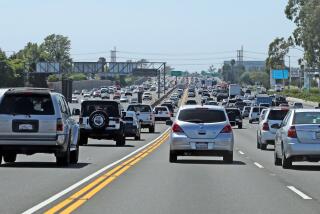Simulator Aimed at Life-Saving
WASHINGTON — The federal government is employing a new weapon in the fight to save lives on the nation’s highways--a $56-million driving simulator designed to replicate driving conditions right down to rush hour on Southern California freeways.
Traffic safety officials say the National Advanced Driving Simulator will provide a proving ground, via the virtual reality of computers, to study driver behavior--a factor in 90% of crashes.
But the Center for Auto Safety and the Insurance Institute for Highway Safety are skeptical of the benefits of the driving simulator--billed as the most advanced (certainly the most expensive) ever built.
The simulator will be housed at the University of Iowa, hardly a place associated with Sig-Alerts. But the machine will be used, for example, to study a phenomenon especially common in Southern California--motorists who keep one hand on the wheel and the other cradling the phone to their ear. The machine also will be used to study the proliferation of mobile offices--cars equipped with computers that can send faxes and log on to the Internet.
Such studies could lead to safer cars or new laws--perhaps measures like the one recently enacted in a Cleveland suburb that restricts motorists to using hand-free phones while driving, except in emergencies.
“I think we’re going to learn a lot about the complexity of driving and how we design the vehicles and how we design the roadways,” said Ricardo Martinez, administrator of the National Highway Traffic Safety Administration.
The agency sets safety rules for the auto industry and conducts studies that guide lawmakers in enacting traffic safety laws.
The simulator, scheduled to be in use by May 2000, will employ the kind of advanced technology a Nintendo lover would die for. It will feature a computer-generated 360-degree image of the roadside with such sounds as honking horns and screeching tires. Road conditions will be re-created right down to the bone-jarring potholes.
“There’s just one thing we can’t do. We can’t put rain on the windshield,” said Ed Haug, the project’s founding director and a University of Iowa engineering professor.
Real cars will be mounted inside a large dome that sits on six hydraulic legs. The entire apparatus is built on a platform that moves back and forth on a floor about as big as a basketball court. Drivers will be able to do just about everything they can do on the road--except get hurt.
Computers can add cars to the driving scene or--in something every motorist would love to do in real life--remove traffic. Programmers can add hazards, such as children running out in the street, to test driver reaction.
But unlike video games, if a driver crashes, there is no make-believe explosion. The simulator takes the driver up to the point of impact and then shuts down.
Among the subjects to be studied, officials say, are the effects of aging, fatigue, alcohol and medicines on drivers.
The federal government is spending $44 million on the project. The University of Iowa won a national competition to house the project partly because it offered to contribute $12 million to its development.
One critic, Clarence Ditlow, executive director of the Center for Auto Safety, a Washington-based consumer advocacy group, dismissed the simulator as “pork.” He added: “Pork may be OK in highway [spending], but not in vehicle safety where dollars are limited.”
Brian O’Neill, president of the Insurance Institute of Highway Safety, an insurance industry group based in Arlington, Va., contended that test subjects act differently when they know they’re being studied.
“When teenagers drive with other teenagers, they’re at high risk. Put them in a simulator, and they’ll probably behave like they’re driving with their parents,” he said.
Thomas Sheridan, professor of engineering and applied psychology at the Massachusetts Institute of Technology, disagreed. “These things are realistic enough that you almost forget you’re in a simulator,” he said.
Haug, the University of Iowa engineering professor, insisted the project will prove cost-effective.
“If you could cut crashes on the highway by 1%, you could save a billion and a half dollars [in medical costs, property damage and lost work]. I don’t know any corporate executive who wouldn’t take that return on their investment.”
O’Neill remains skeptical. “We know a big part of driver behavior is not lack of knowledge or lack of skills. It’s a problem of attitude”--people doing things they know they shouldn’t be doing.







